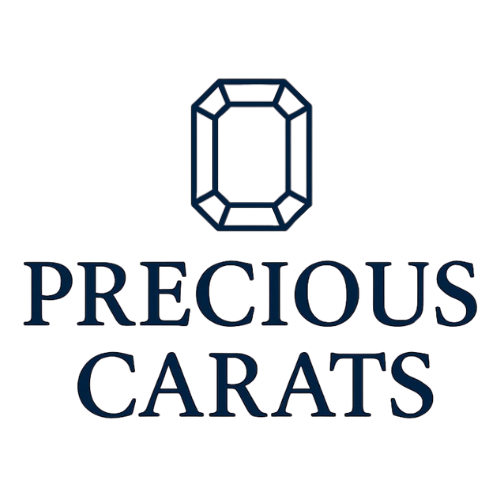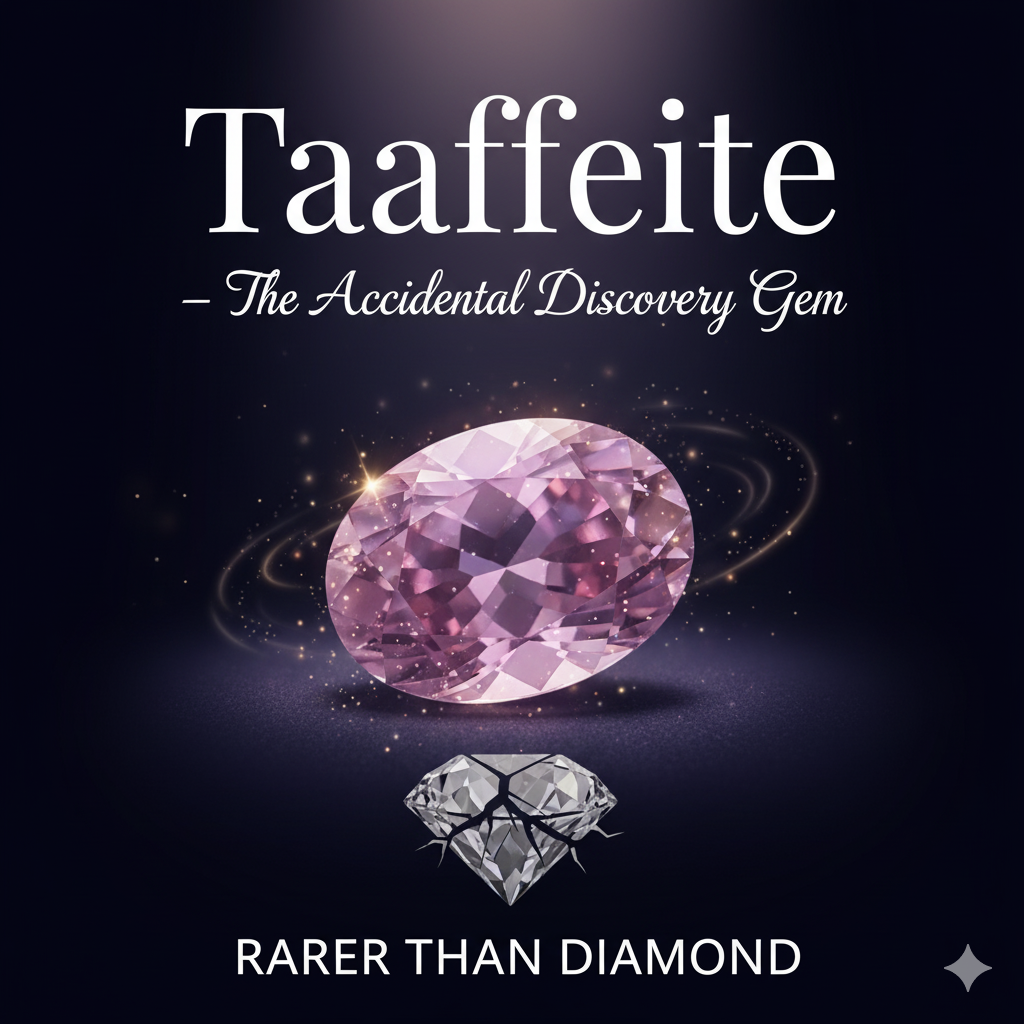Introduction
In the world of gemstones, few names evoke as much intrigue and rarity as Taaffeite. Pronounced ‘TAR-fite,’ this extraordinary gemstone was not discovered in a mine or riverbed like most others, but rather in an already cut stone. In 1945, Austrian gemologist Count Richard Taaffe purchased a parcel of spinels in Dublin, Ireland. Upon closer inspection, he noticed something unusual in one particular stone — it showed double refraction, unlike spinel. This small observation led to the identification of a completely new gemstone, one that would bear his name forever: Taaffeite.
Since its discovery, Taaffeite has gained recognition as one of the rarest gemstones known to humankind. With fewer than a thousand faceted stones believed to exist worldwide, it is thousands of times rarer than diamond. Found primarily in Sri Lanka, Tanzania, and parts of China, Taaffeite appears in delicate hues of lavender, mauve, lilac, pink, violet, and reddish purple. Its rarity and soft, enchanting colours have made it a gem collector’s dream, often compared to alexandrite, Paraiba tourmaline, and Padparadscha sapphire in exclusivity.
Gemmological Identity of Taaffeite
Taaffeite belongs to the mineral family of beryllium aluminum oxide, with the chemical formula BeAl₃O₁₂. It shares structural similarities with both spinel and chrysoberyl but stands distinct in its own right.
Key characteristics:
– Hardness: 8 to 8.5 on the Mohs scale, placing it between spinel and sapphire in durability.
– Crystal system: Hexagonal.
– Refractive index: 1.719 to 1.730.
– Birefringence: 0.008 to 0.010, making it doubly refractive (unlike spinel which is singly refractive).
– Colours: Lavender, lilac, mauve, pink, violet, and reddish-purple shades are most common.
Its double refraction is the key property that allowed Richard Taaffe to distinguish it from spinel. This unique optical trait remains the quickest way to separate Taaffeite from similar-looking gems. Because of its beauty and durability, Taaffeite is suitable for jewellery, though its rarity makes it more common in private collections and museums than in commercial jewellery markets.
Sources and Mining
Taaffeite is primarily found in secondary deposits, meaning it is rarely mined directly. Instead, it appears as a by-product of gem gravels containing spinel, chrysoberyl, and sapphires. This adds to its rarity, as miners seldom target Taaffeite specifically.
Primary sources include:
– Sri Lanka (Ratnapura gem gravels): The classical and most consistent source of Taaffeite.
– Southern Tanzania: Notable deposits have yielded fine stones.
– China: Some limited occurrences have been documented.
Because it is so rare and unpredictable in occurrence, Taaffeite is one of the few gemstones with no dedicated mining operation. Instead, it is discovered incidentally, often mistaken for spinel until advanced testing confirms its identity.
Rarity and Market Value
Taaffeite’s rarity is legendary. It is often said to be a thousand times rarer than diamond, and this is not an exaggeration. Fewer than 1000 cut and faceted Taaffeite gemstones are believed to exist worldwide. The limited number of stones and their exquisite hues make Taaffeite one of the most exclusive gemstones for collectors.
Market value depends on colour, clarity, size, and origin:
– Small stones under 1 carat: $2,000 to $5,000 per carat.
– Stones between 1–2 carats: $5,000 to $15,000 per carat.
– Large stones over 5 carats: $20,000 to $30,000 per carat or higher.
At auctions, fine-quality Taaffeites have sold for significant sums, often rivalling rare alexandrites and sapphires. Collectors prize Taaffeite not just for its beauty but for its rarity and unique history of discovery.
Taaffeite vs Spinel
The story of Taaffeite is inseparable from spinel, the gem it was originally mistaken for. Both share a similar colour range, but gemmologists differentiate them with these key properties:
– Spinel is singly refractive; Taaffeite is doubly refractive.
– Spinel has a cubic crystal system; Taaffeite has a hexagonal system.
– Spinel lacks beryllium, while Taaffeite contains it.
While fine spinels themselves can command high values, Taaffeite’s rarity elevates it into an entirely different league. Collectors who appreciate one often seek the other, but Taaffeite remains dramatically rarer and more exclusive.
Historical and Cultural Significance
Since its identification in 1945, Taaffeite has held a special place in gemmological history as the only major gemstone first discovered in cut form. This unusual origin story has fascinated gem collectors and historians alike. Museums in London, Vienna, and Colombo house some of the earliest specimens, ensuring Taaffeite’s place in the gemstone narrative.
In Sri Lanka, where much of the material originates, Taaffeite is celebrated as part of the island’s rich gem heritage. However, due to its extreme rarity, it has never achieved the widespread recognition of sapphires, rubies, or emeralds. Instead, it remains a gemstone for the elite — those who collect not for fashion but for history and rarity.
Astrological and Metaphysical Beliefs
Unlike sapphire, ruby, or emerald, Taaffeite does not belong to the classical Navratna gemstones of Vedic astrology. However, in modern metaphysical traditions, it has found a unique place. Believers ascribe the following powers to Taaffeite:
– Enhances clarity of vision and decision-making.
– Symbolizes rare opportunities and serendipity, reflecting its unusual discovery.
– Strengthens spiritual awakening, associated with the crown chakra.
– Promotes emotional transformation and inner balance.
Some modern astrologers also suggest Taaffeite as a substitute for diamonds or Venus-related stones due to its brilliance and rarity. Nevertheless, its scarcity means that few can ever wear it for astrological purposes — it remains more of a collector’s jewel than a common astrological remedy.
Buyer’s Guide to Taaffeite
For those fortunate enough to consider purchasing a Taaffeite, here are key guidelines:
– Certification: Always demand reports from reputed labs such as GRS, SSEF, or GIA, as Taaffeite is often confused with spinel.
– Colour: The most desirable colours are vivid lavender, pink, and purple. Greyish or brownish tones reduce value.
– Size: Most stones are under 2 carats. Stones over 5 carats are exceedingly rare and often museum-grade.
– Clarity: As with other gems, eye-clean specimens are valued highest.
– Investment: Given its rarity, Taaffeite holds strong long-term investment potential. Prices have steadily risen as awareness has grown.
Because of its scarcity, Taaffeite is unlikely to ever be mainstream in jewellery. Instead, it appeals to connoisseurs and collectors who appreciate rarity, history, and beauty in equal measure.
Conclusion
Taaffeite is a gemstone that embodies rarity, mystery, and serendipity. Discovered by chance in Dublin and later traced to the gem gravels of Sri Lanka and Tanzania, it remains one of the rarest gemstones on Earth, with fewer than a thousand cut stones known. Its delicate lavender-to-pink hues, durability, and unique gemmological properties make it a treasure for collectors and connoisseurs.
While it may not have the astrological fame of sapphires or the commercial popularity of diamonds, Taaffeite’s exclusivity makes it a crown jewel in the world of rare gemstones. For those lucky enough to encounter it, Taaffeite offers not just beauty, but a piece of gemmological history — a gem that was never meant to be found, yet changed the gemstone world forever.

